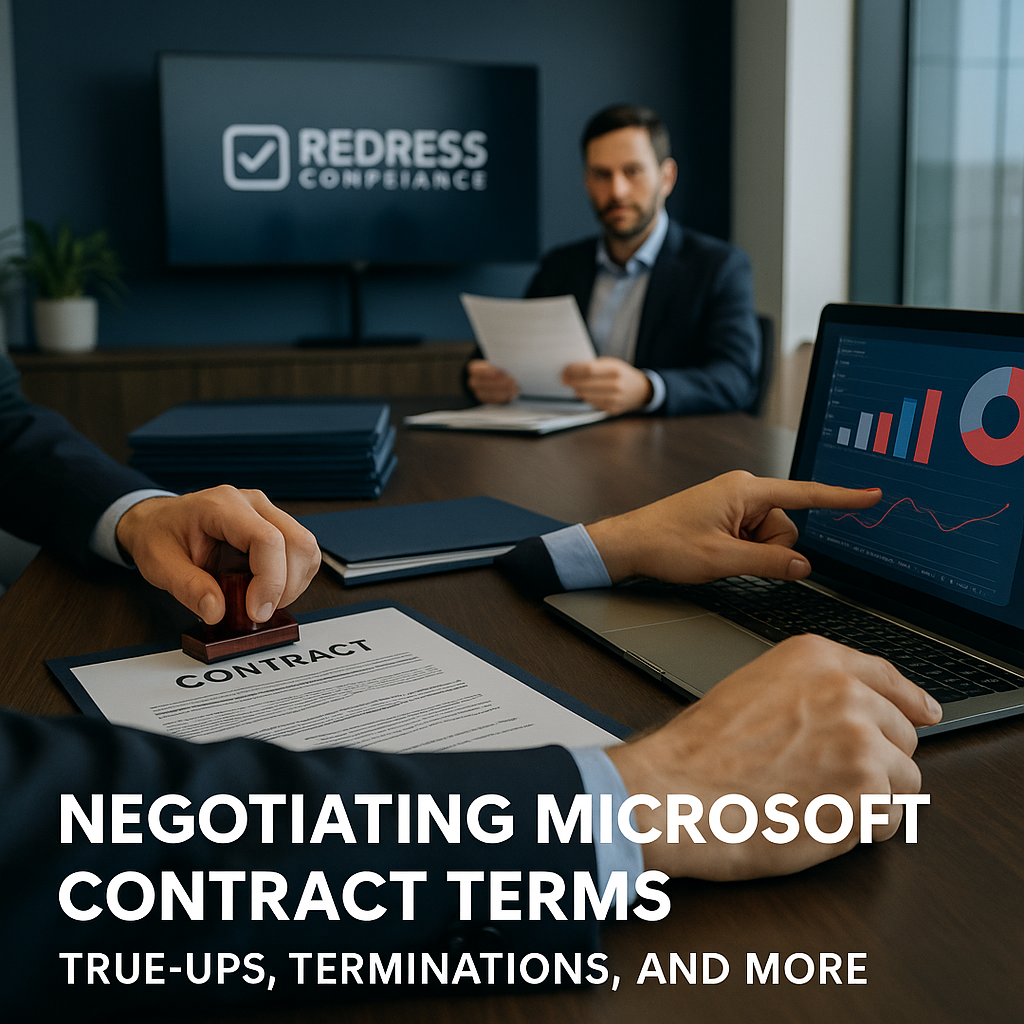Negotiating Microsoft Contract Terms

Introduction – Beyond Price
When negotiating a Microsoft licensing agreement, most people focus on securing bigger discounts.
However, price isn’t the only factor that can make or break the deal’s value. In fact, several non-price contract terms can have an even greater impact on your costs and risks over the agreement’s life.
Procurement leaders and CIOs have learned that terms around license flexibility, renewals, and liabilities can hide huge costs if left unchecked. These hidden pitfalls often turn into Microsoft EA renewal mistakes or compliance surprises.
This article looks beyond the upfront price to highlight key Microsoft licensing contract terms you should negotiate to protect your organization. If you want to have a broad insight into negotiations, read our overview of Microsoft Licensing Contract Negotiation.
We’ll cover true-up clauses, co-termination of agreements, ramp pricing, payment schedules, renewal and termination conditions, and liability and audit terms.
By proactively addressing these areas, you can reduce surprise expenses, avoid costly licensing errors, and ensure the contract aligns with your business’s needs.
True-Up and True-Down Clauses
True-ups are the standard Microsoft mechanism to account for growth: if you add licenses or users during the year, you report and pay for those additions at the annual true-up date.
The catch is that traditionally, you can only increase license counts (true-up), not decrease. This means if your usage drops or you overestimated needs, you’re usually stuck paying for the higher number until the term ends.
That one-way ratchet can lead to surprise costs – for example, if a team shrinks mid-year, you still foot the bill as if nothing changed.
To prevent unwelcome surprises, savvy customers negotiate true-down flexibility. For instance, you could seek the right to reduce up to a certain percentage of licenses at each anniversary or at least at renewal time without penalty.
Another tactic is extending the true-up reporting window – giving you more time to report changes so you’re not rushed into paying for spikes that later recede.
One CIO shared how they negotiated a provision to drop a chunk of licenses if a planned project was canceled; this saved them from paying two more years for 300 unused seats.
Read this to avoid pitfalls: 5 Costly Microsoft Licensing Negotiation Mistakes (and How to Avoid Them).
Co-Termination and Alignment
If your organization has multiple Microsoft agreements or purchases scattered across different dates, you can lose negotiation leverage. Imagine trying to renew one division’s deal this year, another’s next year – Microsoft can tackle each in isolation, and you’re never quite hitting critical mass. The solution is co-termination: aligning contract end dates so everything comes due at the same time.
By negotiating co-termination, you ensure all your Microsoft licenses and agreements renew together.
This way, you create one big renewal event where you have more bargaining power (all your spending is on the table at once).
Co-termination can often be achieved by adjusting newer purchases to expire on the same date as your main Enterprise Agreement or by utilizing flexible programs, such as CSP (Cloud Solution Provider), on a short-term basis to bridge gaps.
It may require extra effort to align all dates, but doing so provides a unified renewal and maximizes negotiating leverage.
Instead of perpetual staggered renewals keeping you on the back foot, you’ll approach Microsoft with a single renewal date and the combined weight of your entire portfolio.
Ramp Pricing and Volume Flexibility
Not every organization wants to buy all their licenses Day One – sometimes you plan to roll out a new service gradually or pilot a technology before full deployment. This is where ramp pricing comes in.
Ramp pricing means structuring the deal so that your committed volume (and costs) start lower and increase over time as your adoption grows. In essence, you’re negotiating a phased increase rather than paying for the peak usage from the start.
For example, if you’re adopting a new Microsoft 365 module or an AI-powered add-on, you might only need 500 users in year one, then 1,000 in year two, and 1,500 in year three. With a ramp deal, you could negotiate pricing that reflects this plan – effectively “pay as you grow.”
This avoids overpaying in the early stages for licenses that sit unused. Microsoft often prefers upfront commitments, but many customers can secure phased commitments or pilot programs to support gradual rollouts.
When discussing volume, also negotiate flexibility for unanticipated changes. If a new product launches or your needs change, try to include terms that allow for reasonable adjustments.
Microsoft might allow swapping one product for another or adding new licenses at a pre-agreed discount. The goal is to avoid a rigid contract that doesn’t adapt – instead, build in options to scale up gradually or pivot without financial penalty.
Use our negotiation tool, Your Microsoft Contract Negotiation Checklist: 10 Steps to Prepare.
Payment Terms and Billing
The way you pay for your Microsoft agreement can significantly affect cash flow. Microsoft’s standard Enterprise Agreement billing is often annual (you pay once per year for that year’s licenses), which is easier than paying everything up front for three years. However, you can take this further: negotiate payment terms that align with your budgeting cycles.
Many large enterprises manage to obtain quarterly billing or extended net payment terms (like net 60 or 90 days) to give themselves breathing room. If you’re making a massive purchase, asking for a more favorable payment schedule isn’t unusual – Microsoft may agree to secure the deal.
Consider the currency and global aspects too. If your company operates in multiple countries, fluctuations in exchange rates could increase your costs over time.
To avoid this, some organizations negotiate protections such as caps on currency conversion rates or the option to transact in local currencies at a fixed rate.
For example, you could cap annual price adjustments due to currency fluctuations at a set percentage, or allow paying in local currency for foreign offices to avoid FX swings.
Also, clarify the invoice and billing process in the contract. Ensure it specifies when invoices come, and try to align payments with your financial quarters.
Don’t assume you must accept Microsoft’s default billing cadence – if a different structure helps your cash flow or accounting, bring it up in negotiations. Often, Microsoft can accommodate alternative payment arrangements for strategic customers.
Renewal and Termination Clauses
Avoid any “silent” auto-renewal language – you don’t want to wake up and find your contract extended for another year or three without an active negotiation.
Instead, insist on an explicit renewal process: the contract should require Microsoft to give you notice of the upcoming expiration (say 90 days or more) and require a positive opt-in (a signed renewal or amendment) to continue the relationship.
This way, you create a natural negotiation point and can decide if you want to renew, change programs, or even walk away. Some companies even negotiate a pricing cap for the renewal if they choose to extend, ensuring they won’t face a sudden sticker shock (for example, capping any price increase at 5%).
On the flip side, consider termination rights within the term. Microsoft’s standard agreements typically lock you in with no easy way out mid-term. However, you might negotiate specific carve-outs that give you an exit or adjustment ability.
For example, negotiate a clause allowing license reductions or termination if you divest a business unit or merge with another company. We’ve seen that happen – a company sold a subsidiary and still had to pay for 400 unused seats until the term ended, all because there was no divestiture clause.
In some cases, very large customers or those with leverage have negotiated broader termination-for-convenience options (often with conditions like providing several months’ notice and possibly paying a termination fee).
Microsoft will rarely agree to this unless the deal is big and the reason compelling, but it doesn’t hurt to ask.
The key is to build in flexibility for business changes. You hope not to use these escape hatches, but simply having them can protect you if strategy shifts or unforeseen events occur.
Liability and Audit Terms
Buried in the contract boilerplate are clauses about liability and audits that can hugely impact your risk.
If left unmodified, you might find Microsoft has wide-open audit rights, and you have virtually unlimited liability for compliance issues. Negotiating these terms is about mitigating risk and avoiding unpleasant surprises.
First, look at liability. Most Microsoft agreements will limit Microsoft’s liability (for any damages to you) quite strictly, but that doesn’t automatically limit your liability. It’s fair to ask for mutual liability caps – meaning both parties’ potential damages are capped at a certain amount (often tied to the contract value).
This ensures, for instance, that if something goes awry, neither side can claim astronomical damages. It can also cover things like data protection responsibilities – if Microsoft fails to meet a promised security standard, you might want remedies spelled out, and vice versa.
Audits are the other big concern. Microsoft reserves the right to audit your software usage to ensure compliance, but you can negotiate the ground rules.
To avoid disruptions and ambush findings, set limits like no more than one audit per year (or per agreement term) and require sufficient notice (e.g., 30–60 days) before any audit begins. You can also specify that any audit should be performed by an independent third-party auditor rather than directly by Microsoft’s own staff.
This adds neutrality and can make the process less adversarial. Additionally, smart customers negotiate a clause that if an audit discovers you’re under-licensed, you get a grace period to purchase the needed licenses at the agreed contract discount, rather than paying the full list price or penalties.
By addressing liability and audit terms, you keep compliance risk manageable. You’re ensuring that an audit doesn’t turn into a fishing expedition or a budget-busting event, and that each party bears fair responsibility if things go wrong.
Checklist – Key Microsoft Contract Terms to Negotiate
To summarize the major terms discussed above, here’s a handy Microsoft negotiation checklist of key contract terms beyond price and what to focus on during your negotiation:
| Term | Why It Matters | What to Negotiate |
|---|---|---|
| True-up/true-down | Prevent surprise costs | Partial true-downs, caps on increases, extended reporting time |
| Co-termination | Align renewals for leverage | Same end date across agreements (coterm everything) |
| Ramp pricing | Avoid overpaying early | Phased deployment pricing, pilot programs |
| Payment terms | Manage cash flow | Annual or quarterly billing, FX rate protections |
| Renewal | Avoid silent lock-ins | Explicit opt-in (no auto-renew), advance renewal notice |
| Termination | Flexibility for business changes | Carve-outs for M&A/divestiture, early exit options |
| Liability/audits | Limit risk | Mutual liability caps, audit frequency limits, third-party audits |
Use this checklist as you prepare for your Microsoft contract negotiation. It ensures you won’t overlook these critical clauses while chasing a discount on pricing.
FAQs
Can Microsoft true-up terms be negotiated? → Yes – you can push for caps and extended reporting windows.
Are co-termination clauses standard in Microsoft deals? → No – you must explicitly negotiate them.
Can the auto-renewal of a Microsoft agreement be turned off? → Yes – require an explicit opt-in (no auto-renewal).
How flexible are Microsoft’s payment terms? → Quite flexible – large customers often get extended payment schedules.
Can liability and audit terms in a Microsoft contract be adjusted? → Yes – negotiate mutual liability caps and audit limitations.
Read more about our Microsoft Negotiation Services.
